Goncharova and Larionov
Goncharova and Larionov
Listen to curator Peter Vangioni's lecture on Goncharova and Larionov: L'Art Décorative Théâtral Moderne. Recorded on Wednesday 19 May 2010.
Related reading: In Modern Times
Notes
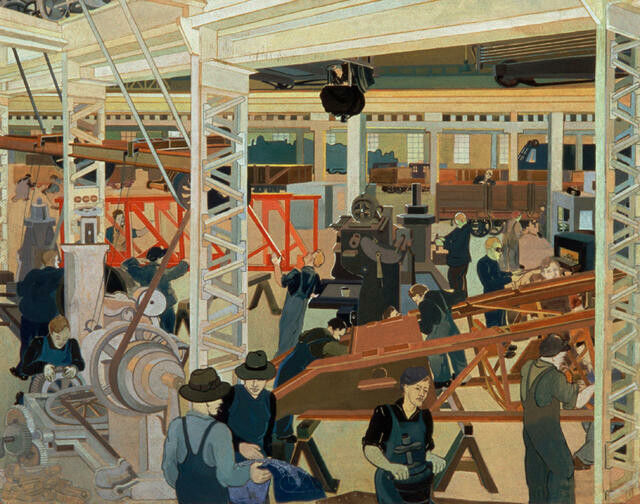
Tracking Louise Henderson
I recently wrote about Louise Henderson's painting Addington Workshops (1930) for the Press, and wanted to locate the place in which she stood to make the sketch for the work. It's a complex image and I wanted to understand more about its internal space as well as its history, but the workshops were demolished twenty years ago.
Notes
L’Art Décoratif Théâtral Moderne
A new exhibition of stage and costume designs by Russian avant-garde artists Natal'ya Goncharova and Mikhail Larionov opens this month.
Collection
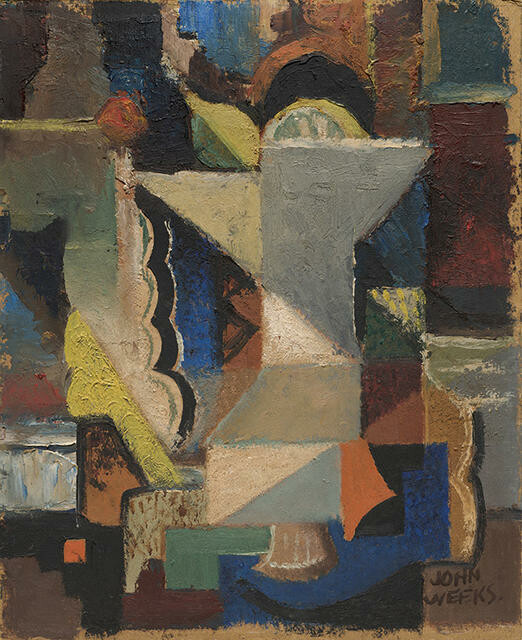
John Weeks Still Life
This work is from the Canterbury Public Library’s collection of original art works. This collection was started by Ron O’Reilly (1914-1982), who was appointed City Librarian in 1951. He had a keen interest in philosophy, literature and New Zealand art and developed personal friendships with many artists including Doris Lusk, Olivia Spencer Bower, Colin McCahon and Toss Woollaston. During his time in Christchurch he was deeply involved in the local art scene. He arranged many exhibitions in the library one such being McCahon’s The Wake in 1959. He liaised with other galleries in arranging the loans of paintings for other exhibitions, and for a period was art critic for the Press and picture buyer for the CSA Gallery. In 1953 the Library started its hire service of framed art prints, a selection of 80 reproductions which was confined to works by artists of importance in the history of painting, both old and modern masters. Shortly afterwards the Library’s collection was augmented by two substantial gifts, one from the Redfern Gallery, London of 34 original lithographs by British artists and the other, 39 prints from French cultural funds. In 1955 the City Council approved extension of the picture loan service to include original art works by local artists. The maximum purchase price was to be 19 guineas and because of this limitation the artists were often persuaded to sell their work at reduced prices. The prospect of having one’ s work on such public display was also an inducement to the artist to sell at a reasonable price. By 1960, 50 original works had been acquired. The paintings were selected by Ron O’Reilly at exhibitions, galleries and by visiting the artists in their homes.
In 1981, when purchasing ceased, the collection consisted of 297 works. 155 of these were gifted to the Robert McDougall Art Gallery in 2001. Adapted from “Library Treasures: New Zealand art works from the collection of the Canterbury Public Library, exhibited at the CSA Gallery, 9 February to 5 March 1989”.
Collection
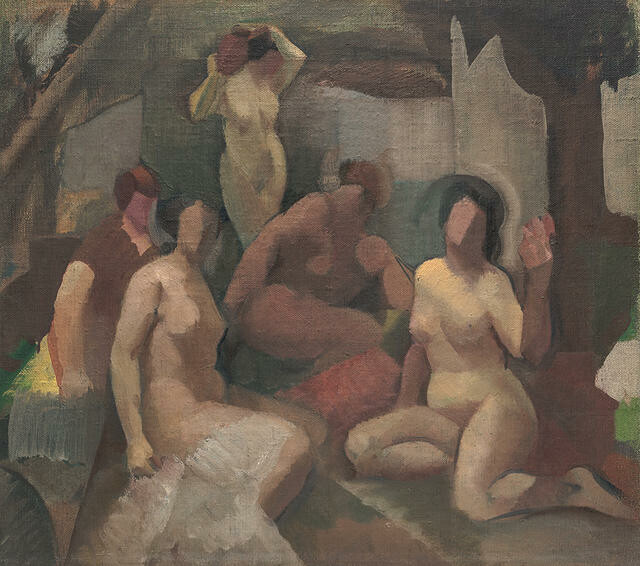
John Weeks Group Figure Study
John Weeks was regarded as New Zealand's leading exponent of modern painting for a considerable period. A teacher at the Elam School of Fine Arts in Auckland from 1930–54 he played an important role in connecting younger artists to the major developments in modern art of the early twentieth century. His reputation was enhanced by having studied and worked abroad for many years.
An ambulance medical corps officer in Britain and France during World War I, he studied art in Edinburgh from 1923, then in Paris at the studio of the cubist painter André Lhote from 1925, where he returned in 1928 after extended painting sojourns in Italy, North Africa and the South of France. (In Modern Times, 18 December 2015 – 11 September 2016)
Collection
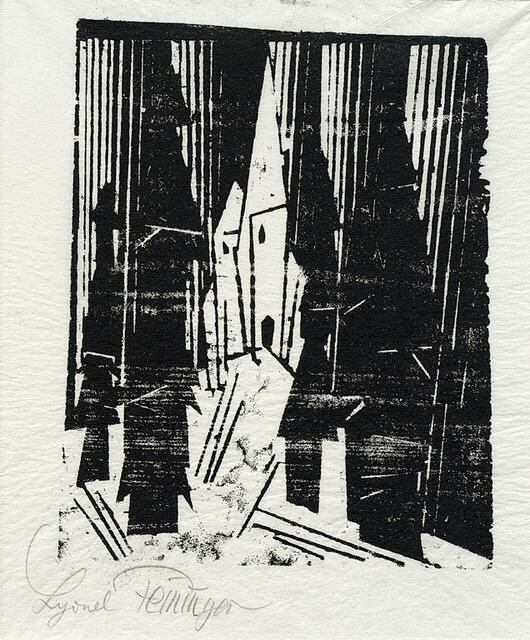
Lyonel Feininger Wald Kirche, 2
The American-born artist Lyonel Feininger had been living in Europe, mainly in Germany, since 1887. He visited Paris in 1911 while exhibiting work at the Salon des Indépendents, where the cubists were exhibiting their discoveries for the first time. Writing to a friend in 1913 from Berlin, Feininger described the moment: “In that Spring I had gone to Paris for two weeks and found the art world agog with Cubism – a thing I had never heard even mentioned before, but which I had already, entirely intuitively, striven after for years.”
Feininger’s artistic development from this point led to an invitation in 1919 from the German architect Walter Gropius to become the first master at the Bauhaus,a new school of art at Weimar. He produced many woodblock prints for their publications, including a futurist-inspired cover for their first manifesto, featuring a cathedral in a forest, a theme to which he often returned. (In Modern Times, 18 December 2015 – 11 September 2016)
Collection
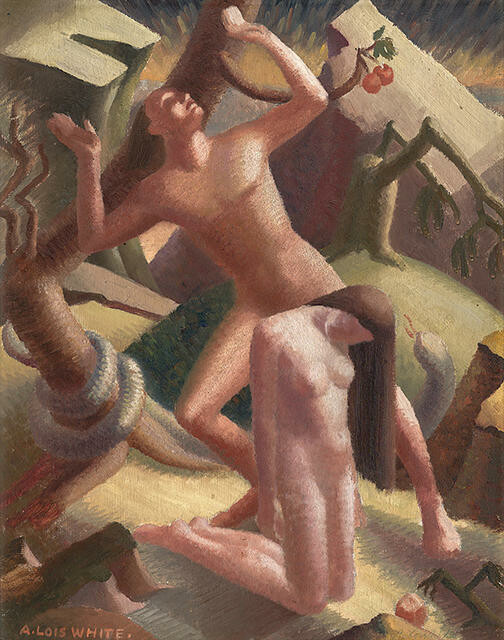
A. Lois White Expulsion
Lois White was a prominent, individualistic voice in New Zealand painting in the 1930s and 1940s, who attracted attention with her modernistic, art-deco style figure compositions.
A student at Elam School of Fine of Arts in Auckland in the 1920s, White also taught there for many years from 1928. Equally interested in the old masters as in the cubists and other modern painters, she admitted looking at “anything that I could get my eyes and brain working on […] I was very taken with all the figure compositions of Botticelli.”
Such varied sources are evident in her dramatic depiction of Adam and Eve, the first humans in the biblical account of the creation of the world. Painted at the start of World War II, it may be seen as an allegorical reflection on the human condition. (In Modern Times, 18 December 2015 – 11 September 2016)
Collection
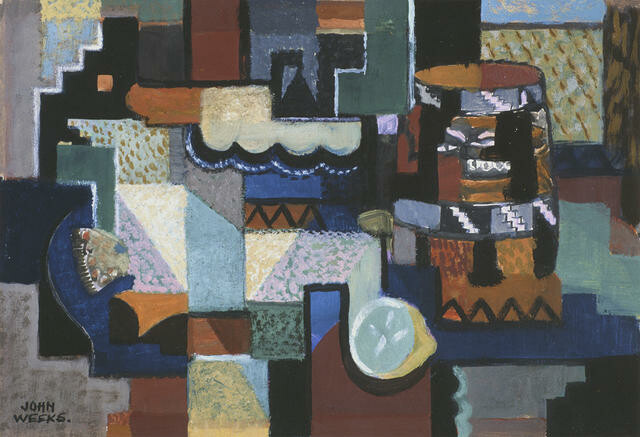
John Weeks An Arrangement in Colour
The Auckland painter John Weeks returned to New Zealand in 1929 after seven years abroad, having painted and travelled in Europe and North Africa, and studied in the Paris studio of the cubist painter André Lhote.
Appointed as a teacher at the Elam School of Fine Arts in 1930, Weeks found New Zealand a virtual clean slate in relation to modern art, for which he became a pragmatic, steadfast champion. Versatile in his output, he painted mildly abstracted landscapes and figure studies that recalled the lessons of Paul Cézanne. From about 1945 onwards, he also began exhibiting more boldly abstract compositions such as these, echoing the earliest years of cubism and the paintings of Pablo Picasso and Georges Braque.
(In Modern Times, 18 December 2015 – 11 September 2016)
Collection

Ted Bracey Painting (City Within)
Ted Bracey painted this jazzily modernistic work while in his final diploma year in 1959 at the University of Canterbury School of Fine Arts. Echoing the early analytical cubist paintings of Georges Braque, it also shows the influence of Paul Klee and Lyonel Feininger, all of whom Bracey had studied, even if only through reproductions. The ongoing possibilities of cubism were also being drawn out at this time by his peers and more established New Zealand painters including Louise Henderson and Colin McCahon.
Bracey, then twenty-three, exhibited this work in the 1959 Group exhibition, after which it nearly became the first purely abstract painting to enter the city’s art collection. Its modernity, however, proved a stumbling block when city councillors controversially overruled the Gallery’s art advisory committee recommendation to buy it. The painting was purchased directly from Bracey in 2002, shortly after his retirement as head of the School of Fine Arts. (In Modern Times, 18 December 2015 – 11 September 2016)
Collection
Natalia Goncharova 'Une Espagnole' Illustrations du ‘Simoun' de Parnack
Russian avant-garde painter Natalia Goncharova settled in Paris with her artistic partner Mikhail Larionov in 1918. The following year they produced L’Art Décoratif Théâtral Moderne (Modern Theatrical Decorative Art), the folio of sixteen lithographs and pochoir (stencil) prints from which these works came. Mainly featuring costume designs, it also celebrated their involvement with Serge Diaghilev’s Ballet Russes. Natalia was first drawn to the Spanish theme while with the ballet company in Spain in 1916, designing costumes for Rhapsodie Espagnole, a production that was never staged. Diaghilev is said to have been upset when told that Grime (Make-up) was his own wildly abstracted portrait.
(Perilous: Unheard Stories from the Collection, 6 August 2022- )
Collection
Mikhail Fyodorovich Larionov, Natalia Goncharova Des Fleurs
This print is from the folio L’Art Décoratif Théâtral Moderne (Modern Theatrical Decorative Art) produced in Paris in 1919 by leading European avant-garde artists Natal’ya Goncharova (1881–1962) and Mikhail Larionov (1881–1964). Including examples of the artists’ work in lithography and pochoir (stencil) printing, the folio highlights not only their interest in stage and costume design, but also their desire to combine the forms of cubism with the representation of movement. In 1912 Larionov initiated rayonism, an artistic genre in which he investigated the effect of light rays fracturing and reflecting off the surface of objects. The prints included in L’Art Décoratif Théâtral Moderne, with their rich decorative patterns, vibrant colours and abstract forms, highlight these concerns.
Goncharova and Larionov first met in 1898 as students at the Moscow School of Painting, Sculpture and Architecture and remained lifelong companions. Both artists were founding members of leading Russian avant-garde movements, including the Donkey’s Tail (1912), and worked with the renowned founder of Ballets Russes, Serge Diaghilev (1872–1929), from 1914. In 1919 they relocated to Paris, where they became prominent figures in the city’s artistic, dance and literary circles. Today they are widely regarded as the foremost Russian artists of the twentieth century.
L’Art Décoratif Théâtral Moderne was presented to the Gallery by Anita Muling in 1979.